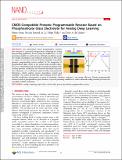| dc.contributor.author | Onen, Murat | |
| dc.contributor.author | Emond, Nicolas | |
| dc.contributor.author | Li, Ju | |
| dc.contributor.author | Yildiz, Bilge | |
| dc.contributor.author | del Alamo, Jesús A | |
| dc.date.accessioned | 2021-10-27T20:30:51Z | |
| dc.date.available | 2021-10-27T20:30:51Z | |
| dc.date.issued | 2021-07-28 | |
| dc.identifier.uri | https://hdl.handle.net/1721.1/136110 | |
| dc.description.abstract | Ion intercalation based programmable resistors have emerged as a potential next-generation technology for analog deep-learning applications. Proton, being the smallest ion, is a very promising candidate to enable devices with high modulation speed, low energy consumption, and enhanced endurance. In this work, we report on the first back-end CMOS-compatible nonvolatile protonic programmable resistor enabled by the integration of phosphosilicate glass (PSG) as the proton solid electrolyte layer. PSG is an outstanding solid electrolyte material that displays both excellent protonic conduction and electronic insulation characteristics. Moreover, it is a well-known material within conventional Si fabrication, which enables precise deposition control and scalability. Our scaled all-solid-state three-terminal devices show desirable modulation characteristics in terms of symmetry, retention, endurance, and energy efficiency. Protonic programmable resistors based on phosphosilicate glass, therefore, represent promising candidates to realize nanoscale analog crossbar processors for monolithic CMOS integration. | en_US |
| dc.language.iso | en | |
| dc.publisher | American Chemical Society (ACS) | en_US |
| dc.relation.isversionof | 10.1021/acs.nanolett.1c01614 | en_US |
| dc.rights | Creative Commons Attribution-Noncommercial-Share Alike | en_US |
| dc.rights.uri | http://creativecommons.org/licenses/by-nc-sa/4.0/ | en_US |
| dc.source | MIT web domain | en_US |
| dc.title | CMOS-Compatible Protonic Programmable Resistor Based on Phosphosilicate Glass Electrolyte for Analog Deep Learning | en_US |
| dc.type | Article | en_US |
| dc.contributor.department | MIT-IBM Watson AI Lab | |
| dc.contributor.department | Massachusetts Institute of Technology. Department of Materials Science and Engineering | |
| dc.contributor.department | Massachusetts Institute of Technology. Department of Nuclear Science and Engineering | |
| dc.contributor.department | Massachusetts Institute of Technology. Microsystems Technology Laboratories | |
| dc.relation.journal | Nano Letters | en_US |
| dc.eprint.version | Author's final manuscript | en_US |
| dc.type.uri | http://purl.org/eprint/type/JournalArticle | en_US |
| eprint.status | http://purl.org/eprint/status/PeerReviewed | en_US |
| dc.date.updated | 2021-08-11T13:46:05Z | |
| dspace.orderedauthors | Onen, M; Emond, N; Li, J; Yildiz, B; del Alamo, JA | en_US |
| dspace.date.submission | 2021-08-11T13:46:06Z | |
| mit.journal.volume | 21 | en_US |
| mit.journal.issue | 14 | en_US |
| mit.license | OPEN_ACCESS_POLICY | |
| mit.metadata.status | Authority Work and Publication Information Needed | |
